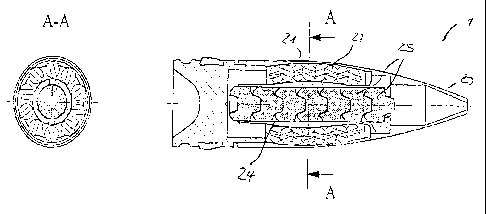Some of the information on this Web page has been provided by external sources. The Government of Canada is not responsible for the accuracy, reliability or currency of the information supplied by external sources. Users wishing to rely upon this information should consult directly with the source of the information. Content provided by external sources is not subject to official languages, privacy and accessibility requirements.
Any discrepancies in the text and image of the Claims and Abstract are due to differing posting times. Text of the Claims and Abstract are posted:
| (12) Patent: | (11) CA 2534842 |
|---|---|
| (54) English Title: | UNIVERSAL KE PROJECTILE, IN PARTICULAR FOR MEDIUM-CALIBRE MUNITIONS |
| (54) French Title: | PROJECTILE KE UNIVERSEL DESTINE NOTAMMENT A DES MUNITIONS DE MOYEN CALIBRE |
| Status: | Granted and Issued |
| (51) International Patent Classification (IPC): |
|
|---|---|
| (72) Inventors : |
|
| (73) Owners : |
|
| (71) Applicants : |
|
| (74) Agent: | SMART & BIGGAR LP |
| (74) Associate agent: | |
| (45) Issued: | 2008-05-06 |
| (86) PCT Filing Date: | 2004-11-18 |
| (87) Open to Public Inspection: | 2005-08-11 |
| Examination requested: | 2006-02-06 |
| Availability of licence: | N/A |
| Dedicated to the Public: | N/A |
| (25) Language of filing: | English |
| Patent Cooperation Treaty (PCT): | Yes |
|---|---|
| (86) PCT Filing Number: | PCT/EP2004/013078 |
| (87) International Publication Number: | WO 2005073664 |
| (85) National Entry: | 2006-02-06 |
| (30) Application Priority Data: | ||||||
|---|---|---|---|---|---|---|
|
The aim of the invention is to combine the cascade effect of frangible pellets
(25) with
sub-projectiles (27, 28, 30) consisting of a ductile heavy metal and thus to
create
ammunition (10) that combines the advantages of, for example, frangible
pellets (25) of a
central penetrator (24) with the advantages of the ductile heavy metals (27,
28) of an
external penetrator (26). This permits an improved performance to be achieved
for
different targets even at low impact velocities. The external penetrator is
arc-shaped or
banana-shaped.
L'invention vise à associer l'effet cascade des pastilles désintégrantes (25) avec des sous-projectiles (27, 28, 30) réalisés en métal lourd ductile, c'est-à-dire à créer une munition (10) qui allie l'avantage, par exemple, des pastilles désintégrantes (25) d'un pénétrateur central (24) aux avantages des métaux lourds ductiles (27, 28) d'un pénétrateur externe (26). Cela permet d'obtenir une puissance améliorée dans différents objectifs même pour des vitesses d'impact profondes. Le pénétrateur externe est réalisé en forme d'arc ou de banane.
Note: Claims are shown in the official language in which they were submitted.
Note: Descriptions are shown in the official language in which they were submitted.

2024-08-01:As part of the Next Generation Patents (NGP) transition, the Canadian Patents Database (CPD) now contains a more detailed Event History, which replicates the Event Log of our new back-office solution.
Please note that "Inactive:" events refers to events no longer in use in our new back-office solution.
For a clearer understanding of the status of the application/patent presented on this page, the site Disclaimer , as well as the definitions for Patent , Event History , Maintenance Fee and Payment History should be consulted.
| Description | Date |
|---|---|
| Common Representative Appointed | 2019-10-30 |
| Common Representative Appointed | 2019-10-30 |
| Change of Address or Method of Correspondence Request Received | 2018-03-28 |
| Grant by Issuance | 2008-05-06 |
| Inactive: Cover page published | 2008-05-05 |
| Inactive: Final fee received | 2008-02-15 |
| Pre-grant | 2008-02-15 |
| Inactive: IPRP received | 2008-01-23 |
| Inactive: Office letter | 2007-11-20 |
| Inactive: Amendment after Allowance Fee Processed | 2007-09-28 |
| Amendment After Allowance (AAA) Received | 2007-09-28 |
| Notice of Allowance is Issued | 2007-08-22 |
| Letter Sent | 2007-08-22 |
| Notice of Allowance is Issued | 2007-08-22 |
| Inactive: Approved for allowance (AFA) | 2007-07-30 |
| Inactive: Correspondence - Transfer | 2006-11-24 |
| Letter Sent | 2006-09-14 |
| Letter Sent | 2006-09-14 |
| Letter Sent | 2006-09-14 |
| Inactive: Single transfer | 2006-07-25 |
| Inactive: Courtesy letter - Evidence | 2006-04-11 |
| Inactive: Cover page published | 2006-04-10 |
| Inactive: Acknowledgment of national entry - RFE | 2006-04-05 |
| Letter Sent | 2006-04-05 |
| Application Received - PCT | 2006-02-28 |
| National Entry Requirements Determined Compliant | 2006-02-06 |
| Request for Examination Requirements Determined Compliant | 2006-02-06 |
| All Requirements for Examination Determined Compliant | 2006-02-06 |
| Application Published (Open to Public Inspection) | 2005-08-11 |
There is no abandonment history.
The last payment was received on 2007-10-22
Note : If the full payment has not been received on or before the date indicated, a further fee may be required which may be one of the following
Please refer to the CIPO Patent Fees web page to see all current fee amounts.
Note: Records showing the ownership history in alphabetical order.
| Current Owners on Record |
|---|
| RWM SCHWEIZ AG |
| Past Owners on Record |
|---|
| JAKOB BURRI |